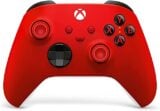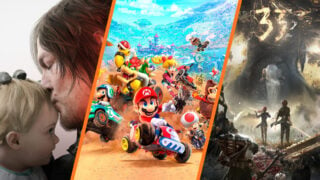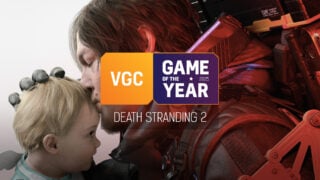Great game ideas that never took off
Xbox Snap, Game Boy Micro… we miss them all

This article was provided by Tired Old Hack.
Over the years, the world of video games has seen an endless supply of mishaps and failed ideas.
The vast majority of these slip-ups were fundamentally flawed at their core; the likes of Virtual Boy, Kinect and the Atari Jaguar died off because they simply weren’t very good.
On rare occasions, however, something wont resonate with an audience even if the concept is solid. For whatever reason – bad marketing, a lack of developer support, even just being ahead of its time – some genuinely good ideas have found themselves unceremoniously left by the wayside.
Here are just a few notable games features that never quite took off (and we wish they had)…
The Game Boy Micro

The final member of the Game Boy family launched in 2005, and was hyped by Nintendo as one of the smallest video game systems ever made.
At just 10 x 5cm in size and less than 2cm thick, the Micro easily fulfilled the promise many handhelds couldn’t: you could put it comfortably in your pocket without it looking like you were on the way to an enemy’s house to put a brick through their window.
Its dinky 2-inch screen was a thing of beauty: because it was so small its meagre 240×160 resolution still managed to look stunning, making every GBA game look sharp as a tack (though because of its size it couldn’t play original Game Boy or Game Boy Color carts).
The Game Boy Micro is one of many fans’ prized possessions, and is still used to this day: it’s perfect for when you’re travelling light, especially since its battery can last anything from 5 to 10 hours depending on your brightness settings.
“The Game Boy Micro is one of many fans’ prized possessions, and is still used to this day: it’s perfect for when you’re travelling light.”
What went wrong?
Although the Game Boy Micro was a beautiful little piece of kit, it came at a time when the Game Boy Advance was already on its deathbed.
Nintendo’s shiny new DS system had already been on the market for up to a year (depending on the region) by the time the Micro launched, meaning most fans had already either moved on or decided they were happy enough with their Game Boy Advance SP.
As a result the Micro ‘only’ sold 2.42 million units worldwide. That may seem like a decent number, but consider Nintendo shifted 81.5 million GBA systems in total and it’s clear the Micro simply turned up too late to the party.
System faceplates

Don’t you hate it when Nintendo, Sony or Microsoft release a fancy limited edition version of a console you already own?
Suddenly that system you loyally bought on launch day looks like a plain old wedge compared to the snazzy new version designed to look like R2-D2 or Pikachu.
In an alternate universe, this would never have happened. In 2005, both Microsoft and Nintendo came up with a clever way to ensure your console could always change according to your mood: faceplates.
The Xbox 360 and the aforementioned Game Boy Micro each let you remove the casing and replace it with another design of your choosing.
“In 2005, both Microsoft and Nintendo came up with a clever way to ensure your console could always change according to your mood: faceplates.”
Naturally, this was an ‘each sold separately’ situation, but I’m sure you’d agree that in hindsight £12.99 on a new faceplate was a slightly less bitter pill to swallow than having to drop £300 on a brand new console.
What went wrong?
Simply put, nobody bought them. It turns out most players were happy enough with plain black, white or coloured systems and didn’t feel like changing designs on a whim.
“We don’t ever create an accessory with the intent of having it fail”, Microsoft’s Albert Penello told Official Xbox Magazine in 2010. “The idea wasn’t bad … people used to put faceplates on their cell phones. Rewind five years, faceplates were what everybody wanted to do. It turned out nobody bought it. We killed that one pretty quickly.”
Nintendo tried it again years later with the New 3DS, which also launched alongside a bunch of (fantastic) faceplates. Once again, no deal.
Timed Achievements

When the Xbox One launched in late 2013, Microsoft promised to shake up the Achievement system that had been such a popular feature of the Xbox 360.
It did this with Challenges, timed Achievements that had an expiry date and gave special awards like in-game items or one-off background images if you completed them.
Some of these Challenges were straightforward enough – win a game of Madden during its first week of release – while others required a little more work. Battlefield 4, for example, asked you to play 100 online matches within 21 days.
The point of Challenges was to give each game a more living and breathing achievement system rather than a flat 1000 Gamerscore that could be finished in a few days.
“Developers weren’t on board with the idea of continuing to add new achievements to their games after release with no clear benefit to them.”
The way Microsoft envisaged it, developers would keep adding new Challenges on a regular basis so players could load up their old games and continue to enjoy them long after launch.
What went wrong?
Developers weren’t on board with the idea of continuing to add new achievements to their games after release with no clear benefit to them.
While at launch practically every game had its own series of Challenges, at the time of writing a mere three games, all of which – Forza Horizon 3, Gears Of War 4 and State Of Decay – are first-party, have active Challenges.
Pressure sensitive buttons

Way back in 1987, Capcom released the original Street Fighter in arcades. It had an interesting gimmick: the deluxe version of the cabinet featured just two buttons – punch and kick – which delivered different strengths of attack depending on how hard you hit them.
The idea was met with a resounding “meh” and Capcom ditched the idea for the infinitely better Street Fighter II.
The pressure-sensitive button gimmick lay dormant for 13 years, until it was brought back for a little-known device called the PlayStation 2.
Yes, most people have completely forgotten this, but the standard DualShock 2 controller that comes with the PS2 has pressure-sensitive face buttons and shoulder buttons, as well as a pressure-sensitive D-Pad.
“Yes, most people have completely forgotten this, but the standard DualShock 2 controller that comes with the PS2 has pressure-sensitive face buttons and shoulder buttons, as well as a pressure-sensitive D-Pad.”
This was most obvious in racing games, some of which featured analogue acceleration and braking which were dependent on how hard you pushed the button.
When Microsoft entered the console market with the Xbox a year later, it too gave its controller pressure-sensitive buttons, and this too was forgotten by most people (except those who were addicted to Dead Or Alive Xtreme Beach Volleyball and its odd pool-hopping mini-game).
What went wrong?
The reality is that pressure sensitive buttons sounded great in theory but were a pain in practice.
Or, to be more specific, a pain in the thumbs. Jamming down the X button to make sure you were accelerating fully was extremely uncomfortable during long sessions.
Ultimately, not enough games supported analogue buttons to justify the cost of adding them to the PS3 and Xbox 360 controllers. Instead, they were given analogue triggers to make accelerating and braking in racing games far more comfortable.
The e-Reader

Long before the Kindle existed, Nintendo had its own e-Reader, and it was nothing to do with downloading torrents of Stephen King books.
Instead, it was a nifty little peripheral that plugged into the expansion port on the Game Boy Advance and came with a barcode reader.
The plan was that users would be able to buy new cards for the e-Reader, which would then read the barcodes on the sides of each card: these barcodes contained actual game code which could be processed by the device.
“In a world before DLC, the e-Reader was a clever and cheap way to add new content to games in card form without having to make new cartridges or discs.”
The results came in two forms: some e-Reader cards served as extra items for existing games, such as new town tunes and clothing designs for Animal Crossing (which needed an extra GameCube link cable), bonus levels for Super Mario Advance 4 or special trainer battles in Pokemon Ruby and Sapphire.
Others were standalone goodies you could scan when only the e-Reader was attached to the GBA with no other games: these included full NES games, mini-games for the card game Mario Party-e and Pikmin mini-games designed to promote Pikmin 2.
In a world before DLC, the e-Reader was a clever and cheap way to add new content to games in card form without having to make new cartridges or discs.
What went wrong?
Although it was a clever idea, in reality the e-Reader was a faff and a half to get going.
Scanning cards sometimes resulted in errors, meaning you had to scan them multiple times, which got frustrating quickly.
What’s more, only tiny amounts of data could be stored on the cards’ barcodes, meaning most half-decent items came on multiple cards. Each classic NES game, for example, consisted of five cards, each with two codes. You had to scan all ten codes in order to access the game.
Ultimately the idea didn’t take off, and Nintendo scrapped the e-Reader before it even made it to Europe.
Xbox Fitness

Picture the scene: It’s November 2013. You’ve just spent $499 at your retailer of choice for a shiny new Xbox One, mandatory Kinect and all.
Your wallet is weeping tears of blood, so you have to start making budget cuts. First thing to go: that pricey gym membership. When you’ve dropped nearly half a grand on a gaming console, your fitness regime has to take a back seat.
Microsoft had your back with Xbox Fitness, a free app that let you try out a variety of well-known fitness programmes – from P90X and Insanity to that one with Jillian Michaels – all while tracking your progress with Kinect.
It was essentially a way of gamifying exercise: as you performed the routines, Kinect would track your movements and tell you whether you were doing the exercises right.
“We genuinely loved Xbox Fitness, and lost plenty of pounds from the time the Xbox One launched to the time the service ended.”
It would also estimate your heart rate and how many calories you were burning, and would score you based on your accuracy, eventually earning you stamps which unlocked achievements (and Challenges, but we’ve already established they were stuffed too).
We genuinely loved Xbox Fitness, and lost plenty of pounds from the time the Xbox One launched to the time the service ended.
What went wrong?
As with many of the non-gaming ideas presented as part of the overall Xbox One package, Microsoft failed to realise that launch window customers were game players first and foremost.
Although Xbox Fitness got off to a good start with players making great use of the free trial exercises available for each programme, those trials didn’t translate into actual purchases of full multi-workout series.
Combine that with the fact that it required Kinect – which many already resented for bumping up the Xbox One’s cost – and it’s clear this one had an uphill climb from the beginning.
Long story short, Xbox Fitness’ sales were nowhere near as healthy as the trainers in its routines, and it coughed and spluttered along until July 2017, at which point Microsoft turned the servers off.
1 vs 100

At the 2009 CES show, Microsoft’s head of Xbox 360 operations Robert Bach introduced a new service called Xbox Live Primetime.
The idea was that some 360 games would be based on scheduled programming, just like a TV channel, which meant everyone would see the same live content at the same time and would be able to discuss it online, at work or in school the next day.
The first Xbox Live Primetime game was 1 vs 100, a live game show created in collaboration with Endemol (the TV company behind the likes of Big Brother and Deal Or No Deal).
Throughout the week, players could take part in trivia contests, with their scores automatically appearing on national leaderboards after each question. The better you did in these regular contests, the more likely you’d play a part in the main live shows.
“Despite receiving a Guinness world record for most contestants in a game show (114,000 players took part one night), Microsoft struggled to make 1 vs 100 profitable”
Taking place every Tuesday and Friday, these two-hour shows were hosted by an actual person. Each round chose a single player (‘the One’) and put them against 100 other players (‘the Mob’), in an attempt to see who would get a question wrong first. If the One survived, they would win up to 10,000 Microsoft Points (about £85 in store credit), whereas if they got knocked out the winnings would be split among whoever was still left in the Mob.
Meanwhile, everyone else taking part was considered the ‘crowd’, and could still play along, answering questions in the hope of being selected as the 1 or 100 for the next round.
What went wrong?
Despite receiving a Guinness world record for most contestants in a game show (the North American version had 114,000 players taking part one night), Microsoft struggled to make 1 vs 100 profitable despite securing ad deals with the likes of Sprint and Honda.
After two fantastic seasons, Microsoft pulled the plug on both 1 vs 100 and the Xbox Live Primetime concept as a whole.
Asymmetric gaming

After introducing (or re-introducing) a whole new audience to video games with Wii, Nintendo’s plan to go one better for its upcoming Wii U system was asymmetric gaming, a concept that proved as difficult to sell as its name suggests.
At E3 2012, Nintendo’s Katsuya Eguchi spent nine minutes explaining how Nintendo Land worked, in particular the Luigi’s Ghost Mansion mini-game.
Long story short, it turned out that asymmetric gaming was a form of multiplayer in which one player sees the action from one angle (on the Wii U GamePad screen) while the others see it from another angle (on the TV).
“Nintendo Land ended up being the best use of asymmetric gameplay throughout the Wii U’s entire lifespan, and the idea died off.”
When the Wii U launched, Nintendo Land actually turned out to be much better than its dull-as-dishwater E3 presentation made it seem. Anyone lucky enough to play the game with three or four pals almost certainly had a great time with its multiplayer mini-games based on the likes of Mario, Animal Crossing, Zelda and Metroid.
It seemed clear that this asymmetric gaming concept was actually quite good fun. Now it was over to other developers to see if they could get similarly inventive use out of the GamePad.
What went wrong?
Nintendo Land ended up being the best use of asymmetric gameplay throughout the Wii U’s entire lifespan, and the idea died off.
After all, following the sheer simplistic genius that was the Wii Remote – where anyone watching Wii Sports tennis knew exactly how it worked within seconds – something that required 10 minutes to explain was never going to be as popular.
Snap Mode

Finally, we’d like to pay our respects to the best idea of this console generation, and its all-too-early demise: Xbox One’s Snap Mode.
Just like it did during the last years of the Xbox 360, Microsoft hyped the Xbox One as more than a gaming device: it was a media service too.
A bunch of media apps were going to be available from day one, including such delights as Netflix, Amazon Prime Video, Hulu, NFL, ESPN, TED, Skype and plenty more.
You could even hook your Xbox One up to your TV aerial or cable box and watch telly through the system’s HDMI passthrough. But what if you couldn’t decide whether to watch a TV show or play a game? Simple, you could do both at the same time.
“Snap was a brilliant feature that let you split your screen into two windows. The bigger window would show your game, while the smaller one would show an app.”
Snap was a brilliant feature that let you split your screen into two windows. The bigger window would show your game, while the smaller one would show an app.
This meant you could play Forza while searching for The Office. Or kill zombies in Dead Rising 3 while tracking your total kill count in the Achievements app. Or play some FIFA while running a Spotify radio channel.
We used Snap all the time. It was fantastically useful during duller gaming moments, like Forza’s hours-long endurance races.
What went wrong?
Again, many Xbox One owners didn’t care much about media, especially if it meant their games would take a hit.
It quickly became clear that the Xbox One was slightly less powerful than the PS4, and part of the reason for that was the percentage of its memory set aside for various non-gaming tasks, in particular Kinect and the OS (including the Snap feature).
Essentially, developers were only allowed to make use of a certain percentage of the Xbox One’s memory, in case a player wanted to Snap a Twitch stream at the same time.
Eventually Microsoft decided that Snap was doing more harm than good, and in early 2017 the feature was dropped.
It’s a shame, because the Xbox One S and X, with their expanded memory, would have been brilliant opportunities to bring Snap back. Alas, it doesn’t look like it’s going to happen, which means we’re going to have to continue to sit our laptops in front of us if we ever want to play GTA V while simultaneously watching Sailor Moon.














